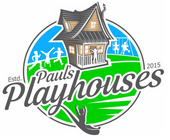
What Materials Should I Use to Build a Playhouse?
 You can use the links below to put your material order in on-line. These links use the Home Depot's website where you can add building supplies to the cart and use their checkout process to have all of the lumber delivered to your home or place of business.
You can use the links below to put your material order in on-line. These links use the Home Depot's website where you can add building supplies to the cart and use their checkout process to have all of the lumber delivered to your home or place of business.
Framing (2x & 4x) ⇢
- Regular Kiln-Dried: The most common and cost effective type of lumber to frame with is regular KD material. Typically these are produced from pine, Douglas fir or other types of softwood. If the structure being built has a roof, or the framing will not be directly exposed to the outside elements, this is the best choice. If the structure will be open, or the framing will be exposed to moisture, the below options are better suited.
- Pressure Treated: The most cost effective way to frame a water resistant and lasting play structure. If the play-set is open or will be exposed to the outside elements, pressure treated lumber is the standard to use. PT lumber has a history of being unsafe for frequent exposure, especially for younger children, however since 2003, the lumber industry has switched away from more toxic chemicals and moved to copper, a much more benign element.
- Cedar / Redwood: These softwoods are naturally more weather resistant and will provide your playhouse with a more premium appearance. The downside to using cedar or redwood is the higher cost compared to KD and PT, and are more prone to dents and marks.
Decking (5/4 x 6) ⇢

- Pressure Treated: PT decking provides little required maintenance to upkeep and the lowest price for a water-resistant material. After 6-12 months, a coat of exterior stain or deck sealant can be applied to help provide even longer protection. This is the most commonly used and recommended decking material.
- Softwood: This type of decking benefits and suffers from the same problems as the framing softwoods. While beautiful when newly installed, it can easily be marked and scuffed, and is not generally recommended.
- Hardwood: For higher budgeted projects, hardwood decking provides the same weather -resistant protection of pressure treated lumber, but adds the beauty and high quality aesthetic of the softwood types.
- Composite: Typically made up of wood fiber, plastic and glue, composite decking provides the least maintenance and highest durability and longevity. A logical next step up from pressure treated and a popular choice when you want to set it and forget it. The downsides are the higher cost, extended installation times and hot surface in the direct sun.
Plywood (4’ x 8’) ⇢

- Sheathing Plywood: The most common and cost effective type of plywood, sheathing grade plywood isn’t sanded or treated and is made up of softer woods. Often coming in the form of CDX or RTD, an exterior paint or stain is recommend in order to help preserve it in the elements.
- Pressure Treated: PT plywood will last longer outside, with the downside of significant added cost. Exterior paint or stain is still recommend after 6-12 months of installation.
- OSB: Although very inexpensive, OSB has a tendency to swell, rot and fall apart pretty quickly when exposed to moisture. This type should only be used when being covered with another type of siding.
- T1-11: A great choice for a more decorative aesthetic. T1-11 is rated for exterior use and commonly found in shed and small structure constriction. It features a wood grain texture with a overlap-underlay connective pattern to eliminate seams. Because T1-11 is more weather resistant and decorative, it is a pricier alternative to normal sheathing plywood.
Trim (1x & 2x) ⇢
- Pressure Treated: Whether it be 1x or 2x material, pressure treated lumber is recommend for window, door and corner trim work. Normal KD is also acceptable if at least two coats of exterior stain is applied to every side, though it’s longevity will still remain less than PT.
Balusters (2x2) ⇢
- Pressure Treated: As with normal framing and decking, PT material is the most cost effective option for exterior balusters. Typically it is sold as single 2x2x36s. More decorative options can be available as well.
- Cedar: Ideal for both exterior and interior railing systems, cedar and redwood balusters are more pricey than PT, but provide a more premium feel to the project.
- Primed & Hardwood: Non-PT balusters are typically better suited for interior railings where pressure treated material is not necessary. These often feature more decorative looks, but are also more expensive.
Screws ⇢

- GRK Screws: We recommend that GRK screws be used in place of nails in most situations, as screws provide more rigidity and flexibility during construction. We found that the GRK brand keeps material from splitting less often and speeds up the construction process. 3” screws should be used to hold framing together, and 2” screws should be used to fasten deck boards and plywood together. For more hardware installation information, see our “How to Attach Rough Framing Together with Screws and Nails” page.
Windows ⇢
- Single Pane Shed Windows: All of the glass windows used in the playhouse designs on this website incorporate single pane shed windows. These windows are designed to be low cost by keeping the construction simple and forgoing energy efficiency. Don’t forget to also apply silicone to the top and sides of the window trim to keep water from leaking inside. For windows and other add-ons, see our playhouse hardware page.
Roofing ⇢
- Asphalt: Provides the most variety in color, styles and cost efficiency. Make sure to purchase about 10-15 percent extra to account for waste.
- Cedar: Beautiful but expensive, cedar shakes can provide a more natural and premium look to your playhouse.
- Metal: Roofs made of metal usually have the best overall longevity over other styles while keeping the price in check. Make sure to purchase a little bit more than what is required.
Accessories ⇢
- Slides, Swings, Windows, Nets & More: We've already done a lot of the work of locating where you can purchase many of the common accessories you will need after the framing is completed.



